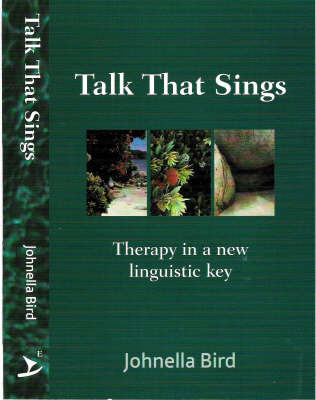
'Talk that Sings introduces Johnella Bird's Relational Linguistic Practice. Through privileging people's words, experiences and meanings, she demonstrates how subtle shifts in language can create profound change. Journeying into the shrouded metaphoric revelations of the everyday, Johnella illuminates the process of creating a 'living' practice. Throughout the text she vividly illustrates her linguistic means of generating the 'Relational I', where the discounted becomes counted, the partially known becomes known, and the unarticulated is brought to life.' To purchase or find out more please visit: www.cybersoul.co.nz.
Foreword
In my first book The Heart’s Narrative I used the description ‘Talk That Sings’ in an attempt to highlight the therapeutic endeavour of finding and creating language that closely represents people’s experiential lives. I was also trying to find the language that accurately described the experiences I had in therapeutic relationships. However, the process of finding language provided me with only a temporary resting place where I could experience the living applicability of this language.
I began to write Talk That Sings after the first Heart’s Narrative workshop in 2000. Listening to the descriptions I gave of the actual therapeutic work, together with the answers I constructed to people’s questions, jostled around and against the textual descriptions I was using. I was particularly drawn to extend and enrich the language I had previously used to describe the construction of the relational ‘I’. This involved naming the numerous technical skills that I use to generate a sense of agency, movement and change. Although Talk That Sings extends my description of the clinical work, I consider this book complements rather than surpasses The Heart’s Narrative.
In Talk That Sings I have taken the opportunity to theoretically and practically describe the relational language-making strategies I use. I believe the use of relational language is pivotal in making both, the often taken-for-granted characteristics of identity visible, and exposing the versions of ‘truth’ people live within. In creating the relational through language, I propose it is possible to make change by languaging into existence the resources people have or could have.
The making of relational language has provided me with a practical resource that enables us (therapist and client) to negotiate a consensus of meaning in regard to significant identity and reality constructing notions. When the relational comes into being through language we can experience a relational consciousness in the making and re-making of the self.
While I was writing Talk That Sings, I was aware of previous criticism of my work where I have been considered either ‘not academic enough’ or ‘too academic’. While I don’t expect to escape this binary, I am offering you (the reader) a variety of ways to begin an engagement with this text. Consequently the book is divided into three sections. I hope these three sections will invite you (the reader) to approach my work from the vantage point that connects you to a sense of intrigue about the dilemmas we experience as people and as counsellors.
In Section One, ‘Relational Consciousness Is The Difference’, I emphasis the theoretical presuppositions that underpin the clinical work I do. I use clinical examples to demonstrate these theoretical constructs.
In Section Two, ‘Relationally Speaking’, I represent 10 key technical practices that I use in therapeutic work. Throughout this section I provide clinical examples and exercises, which will support you (the reader) to develop a resource-centered clinical practice.
In Section Three, ‘Emphasising the Practice’, I demonstrate the relevance of the theory and the technical application of the theory in three central areas: The power of the measure (working with individuals). Couple work (with an emphasis on relationship injuries). Working with children, young people and their families.
Completing this book has been an urgent priority for me. This urgency consists of two strands.
The first is the desire to contribute, which is an ethic born of my family. I believe the use of relational language-making and relational consciousness can significantly contribute to the development of resource-focussed therapeutic practices, which will enact collaboration and respect. Central to this proposition is the view I hold that relational language-making provides us with the capability to negotiate the often complex, contradictory and fragmented nature of power relations.
The second strand is the desire to free myself from feeling an obligation to continue to represent these clinical discoveries in workshops, presentations and conferences. Talk That Sings will inevitably provide me with other metaphoric resting places. However, in the future I plan to use this resting place to prioritise re-searching the clinical areas I am particularly drawn to.
Janet Frame’s short story,The Birds Began To Sing (1983, pp.24-25), sounds a warning to human-kind. Her spare yet vivid and poignant prose illuminates the destruction wrought when the human species is positioned as central and separate from all that is living. The human character in the story attempts to conscript and possess the blackbirds living song. Consequently: “They stopped singing. It was dark outside although the sun was shining. It was dark and there was no more singing.”
Her writing is more eloquent than mine, but in the spirit of this short story I am also sounding ‘a warning’ that is particularly cogent for the human sciences. In the Western world it seems we are driven to own, patent and copyright in an attempt to possess. I believe this act of possession or ownership can destroy or background the environment which fosters the development of creativity. This process is represented in the commodification of therapy and the privileging of textual knowledge over the actual clinical practice. Talk That Sings represents my attempt to provide people with a temporary theoretical and technical platform from which to make discoveries. I am hopeful that this temporary platform will function as a springboard for you (the reader) to develop the metaphoric representations that bring you closer to the theoretical and clinical practice discoveries you will make.
